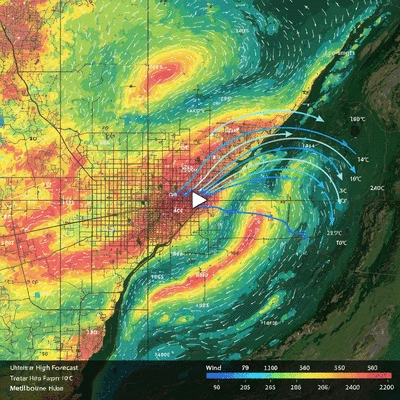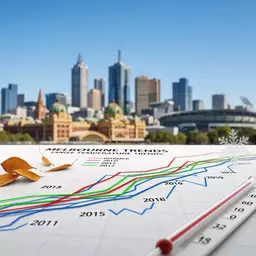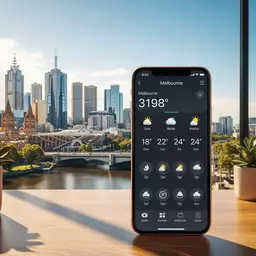Melbourne Temperature Trends Over Time

As Melbourne residents, we know that the weather can change as quickly as our coffee orders. One moment, the sun is shining; the next, a sudden downpour sends everyone scrambling for shelter. Understanding our city's unique seasonal temperature patterns is essential for adapting our daily lives and planning outdoor activities.
What You Will Learn
- Melbourne's summer temperatures can soar between 25°C to 40°C, requiring precautions during heatwaves.
- Autumn temperatures range from 15°C to 25°C, bringing crisp mornings and a colorful backdrop for outdoor activities.
- Winter can be quite variable, with daytime highs of 10°C to 15°C and colder nights dropping to 6°C or lower, highlighting the importance of layering.
- Spring evokes blooming flowers and warming temperatures of 10°C to 25°C, offering an ideal time for outdoor events and activities.
- Historical data reveals long-term warming trends in Melbourne's climate, emphasizing the need for community awareness and proactive adaptation strategies.
- Extreme weather events, such as heatwaves, can affect public health, making it crucial to stay informed and prepared.
Melbourne's Seasonal Temperature Trends
An overview of average seasonal temperatures and historical extremes, highlighting Melbourne's dynamic climate. For more insights into how these trends impact daily life, consider exploring Melbourne weather: a resident's guide.
Seasonal Averages: What to Expect
Summer (25°C-40°C)
Highs often 30°C, heatwaves >40°C. Nights cool.
Autumn (15°C-25°C)
Crisp mornings, cool evenings. Mild days.
Winter (6°C-15°C)
Chilly winds, nights dip lower. Coldest days near 0°C.
Spring (10°C-25°C)
Gradual warming, colorful blooms, occasional rain.
Historical Temperature Insights
Long-term Trends
Over 150 years of data reveal a warming climate; average temperatures have increased locally.
Extreme Events
Jan 2009 heatwave >46°C. Critical for preparedness and adaptation.
Climate Adaptation & Planning
Data-Guided Adaptation
Historical data informs urban planning and risk mitigation strategies.
Community Awareness
Informed choices on travel & daily activities; promotes sustainability.
Understanding Melbourne's Seasonal Temperature Patterns
As a long-time resident and meteorologist, I’ve seen firsthand how Melbourne’s weather can keep us on our toes. Understanding our seasonal temperature patterns is crucial for adapting our daily lives and planning our outdoor activities. In this section, we’ll delve into the temperature trends throughout the year and highlight what you can expect from each season.
Melbourne experiences a unique climate influenced by its geographical position and local features. Let’s take a closer look at the seasonal averages and how they impact our day-to-day experiences.
Seasonal Temperature Averages: What to Expect Throughout the Year
Throughout the year, Melbourne showcases a variety of temperatures that can fluctuate widely. Here’s a quick overview of what you can anticipate:
- Summer: Expect maximum temperatures around 25°C to 40°C.
- Autumn: Averages drop to between 15°C and 25°C, with crisp mornings and cool evenings.
- Winter: Temperatures can range from 6°C to 15°C, often accompanied by chilly winds.
- Spring: Warming temperatures of 10°C to 25°C bring colorful blooms and occasional rain.
It’s fascinating how each season brings distinct temperature patterns, influencing everything from our clothing choices to local events. As we transition from one season to another, it's important to stay informed about these changes, especially with Melbourne's notorious unpredictability. To understand these shifts better, you can also refer to understanding Melbourne's weekly weather trends, which provides a more granular view of temperature fluctuations.
Summer Temperature Trends in Melbourne: Highs and Lows
During summer, Melbourne heats up, with average high temperatures often reaching around 30°C. However, don’t be surprised by heatwaves sending temperatures soaring above 40°C! These extremes can lead to increased energy use and health concerns. It’s essential to stay hydrated and seek shade during the hottest parts of the day.

On the flip side, summer nights can be pleasantly cool, allowing for outdoor dining and evening strolls. Just remember, our summer weather is often marked by sudden changes, so having a light jacket handy can be a game-changer!
Winter Temperature Variability: Coldest Days and Average Conditions
Winter in Melbourne tells a different story. Average temperatures hover around 10°C to 15°C during the day, but don’t underestimate the chill of those winter nights, where temperatures can dip to 6°C or lower! The variability can be stark, with some days feeling much colder due to wind chill.
- Coldest days can drop to 0°C or below, especially in the outer suburbs.
- Snow is rare but possible in the nearby ranges, adding a magical touch to our winters.
- Layering clothing is your best friend during this season!
It’s during these cold months that we often appreciate the warmth of home and community. Understanding this variability can help us prepare better and stay comfortable.
Spring and Autumn: Transitional Seasons and Their Climatic Effects
Spring and autumn serve as transitional periods, beautifully bridging the extremes of summer and winter. During spring, temperatures gradually rise, promoting the blooming of flowers and the return of vibrant colors to our parks. Average highs can reach around 20°C to 25°C, making it a delightful time for outdoor activities.
Autumn, on the other hand, sees temperatures cooling down from summer highs to a more moderate range of 15°C to 25°C. The changing leaves and mild days offer a picturesque backdrop for walks and outdoor events. However, keep in mind that these seasons can also bring unpredictable weather patterns, so being prepared is key!
By grasping these seasonal temperature trends, we can better plan and adjust our lifestyles, ensuring we make the most of Melbourne's dynamic climate.
Historical Temperature Records: Insights from Over 150 Years
To comprehend Melbourne's current temperature trends, we can look back at over 150 years of historical data. This allows us to discern patterns and understand how our climate has evolved. With such rich data, we can gain insights into not just average conditions, but also rare extreme temperature events that have shaped our city's climate narrative.
By analyzing historical records, we can also recognize long-term trends that might hint at changes to come, guiding us in adapting to future weather patterns.
Extreme Temperature Events in Melbourne's Climate History
Melbourne's climate history has seen some remarkable temperature extremes. For instance, the infamous heatwave in January 2009 recorded temperatures surpassing 46°C, leading to significant impacts on health and energy use across the city. Such events remind us how critical it is to stay informed and prepared for the unexpected.
Understanding these extreme events helps us not only appreciate our unique climate but also equips us to take necessary precautions during similar occurrences in the future.
Analyzing Long-term Trends: What Historical Data Tells Us
By delving into the historical temperature data, we can observe notable long-term trends that indicate a warming climate. For instance, average temperatures in Melbourne have slowly increased over the past few decades. This trend reflects broader global patterns and calls for collective action to address climate change.
Recognizing these trends is empowering; it encourages us to contribute positively to our environment and consider how our choices affect the climate.
The Role of the Australian Bureau of Meteorology in Climate Data Collection
The Australian Bureau of Meteorology plays a crucial role in collecting and disseminating temperature data, providing essential insights into our climate. Their ongoing research enhances our understanding of Melbourne’s weather patterns and helps inform public policy and community preparedness initiatives.

By staying connected to the Bureau's resources, we can access reliable information and stay informed about any emerging trends in our local climate. It’s a fantastic tool for anyone wanting to navigate Melbourne's dynamic weather with confidence!
Pro Tip
To make the most of Melbourne's unpredictable weather, consider investing in versatile clothing that can adapt to temperature changes. Layering is key—wear breathable fabrics that can be easily added or removed based on the conditions. This way, you’ll always be comfortable, whether you’re enjoying a sunny day or bracing for a chilly evening!
Summarizing Melbourne's Climate Insights: Past, Present, and Future
Understanding Melbourne's climate is crucial for navigating our unique weather patterns and preparing for what lies ahead. By analyzing historical, current, and future temperature trends, we can equip ourselves with the knowledge needed to make informed decisions. As a Melbourne resident myself, I’ve seen firsthand how these insights can enhance our daily lives and help us plan for various activities, whether it’s a weekend picnic or a business event.
One key takeaway is how historical data informs our approach to climate adaptation. This understanding can guide residents and businesses alike in making strategic decisions that align with our climate realities. By recognizing trends, we can develop effective strategies to mitigate risks associated with extreme weather conditions.
The Importance of Understanding Seasonal Temperature Trends
When we talk about seasonal temperature trends, it's essential to grasp their impact on our daily routines and long-term planning. Historical data serves as a roadmap for future climate adaptations, allowing Melbourne residents to anticipate changes and plan accordingly. You might be surprised to know how much seasonal shifts can affect everything from agriculture to energy consumption!
- Seasonal adjustments in clothing and outdoor activities
- Influence on energy usage and heating costs
- Impact on local flora and fauna, affecting biodiversity
As we navigate these changes, community awareness becomes increasingly important. By staying informed, we can engage in proactive climate planning and make better travel decisions based on expected weather conditions. Just think about how a shift in temperature could affect your weekend plans!
How Historical Data Guides Future Climate Adaptation in Melbourne
The role of historical climate data cannot be understated. By examining patterns from the past, we can identify potential risks and opportunities for adaptation. This data helps to forecast possible temperature fluctuations, guiding us in preparing for extreme weather events.
For instance, historical insights can inform urban planning projects aimed at reducing heat impacts. When we understand our climate's past, we can better shape our city’s future.
The Role of Community Awareness in Climate Planning and Travel Decisions
Community awareness is vital when it comes to climate planning. As residents become more informed about seasonal variations and temperature extremes, they can make savvy choices regarding travel and daily activities. For example, knowing that summer temperatures can soar helps us prepare adequately for outdoor events or even decide when to schedule them.
Engaging with local climate insights not only fosters individual responsibility but also promotes a collective effort toward sustainability. Have you ever considered how your choices impact our city’s climate? Let’s work together to build a more resilient community!
Addressing Public Health Implications Related to Climate Variability in Melbourne
Temperature variability isn't just a weather issue; it has significant public health implications too. Extreme heat days can increase health risks for vulnerable populations, including the elderly and those with pre-existing conditions. It's crucial to stay informed about these changes to protect ourselves and our loved ones.
By understanding climate patterns, we can implement measures to ensure community safety during heatwaves. Awareness means equipping ourselves with the knowledge to act when those temperatures rise!
Engage with Melbourne’s Climate: Stay Informed and Prepared
Staying engaged with Melbourne's climate is more vital than ever. By keeping up with local weather forecasts and climate trends, we can make decisions that align with our environment. At Urban Forecast Hub, we strive to provide the most accurate and insightful data to keep our community well-informed.
As a resident, I encourage you to actively seek out resources and engage in discussions about our climate. Together, we can foster an environment that prioritizes awareness and action!
Encouraging Local Engagement and Environmental Awareness
Building a culture of local engagement is essential for fostering environmental awareness. Participating in community events, workshops, and seminars can help raise awareness about how climate change affects us all. By joining forces, we can amplify our voices and advocate for necessary changes!
- Attend local climate talks or community forums
- Participate in environmental clean-up efforts
- Share your personal experiences and insights with others
Every small action counts, and when we collectively engage, we enhance our ability to adapt and thrive in Melbourne’s unique climate.
Resources for Further Learning: Where to Find More Information
If you're eager to learn more about Melbourne's climate, numerous resources can guide you. Websites like the Australian Bureau of Meteorology provide extensive data and forecasts, while local organizations often host events and informational sessions. Here are a few resources worth exploring:
- Australian Bureau of Meteorology
- Victorian Government Climate Initiatives
- Climate Change Adaptation in Victoria
Using these resources, you can deepen your understanding and become an advocate for sustainable practices in our community. Let’s continue to stay informed and proactive together!
Understanding Climate Communication and Its Importance in Climate Education
Effective climate communication is key to fostering understanding and action. By breaking down complex scientific concepts into relatable and accessible language, we can inspire more individuals to take an interest in their environment. At Urban Forecast Hub, we aim to create content that resonates with our audience and encourages engagement.
By prioritizing clear and engaging communication, we can enhance our community’s climate literacy and empower individuals to make informed decisions. Let’s work together to ensure that everyone in Melbourne understands the importance of our local climate and contributes to a sustainable future!
Recap of Key Points
Here is a quick recap of the important points discussed in the article:
- Summer: Expect maximum temperatures around 25°C to 40°C, with heatwaves reaching above 40°C.
- Autumn: Averages drop to between 15°C and 25°C, characterized by crisp mornings and cool evenings.
- Winter: Temperatures range from 6°C to 15°C, often feeling colder due to wind chill, with potential for sub-zero nights.
- Spring: Warming temperatures from 10°C to 25°C bring vibrant blooms and occasional rain.
- Historical Insights: Over 150 years of data reveal long-term warming trends and the impacts of extreme temperature events.
- Community Awareness: Staying informed about seasonal changes is key to adapting our lifestyles and ensuring public health safety.
Frequently Asked Questions (FAQs) about Melbourne's Seasonal Temperature Patterns
The Australian Bureau of Meteorology plays a crucial role in collecting and disseminating temperature data, providing essential insights into our climate. Their ongoing research enhances our understanding of Melbourne’s weather patterns and helps inform public policy and community preparedness initiatives. For more on how this data is used for urban planning and adaptation, read about Melbourne's urban heat island effect.








